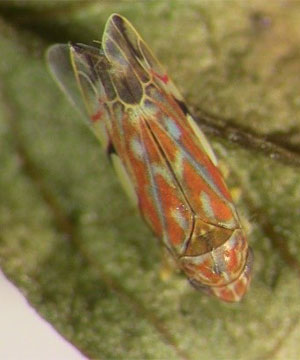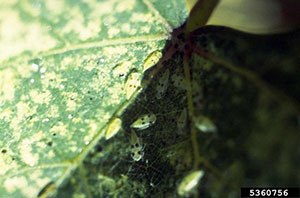by Miranda Ulmer* (12/19)
Quick Facts…
- Leafhoppers overwinter in plant debris and leaf litter; they emerge in the spring and can be found on young grape tissue.
- “Hopper burn” is result of nymphs and adults feeding on the contents of leaf cells and can result in fruit sunburn, delayed fruit ripening and reduced shoot growth the following season.
- Significant leafhopper populations (<15-20) can be tolerated by the grapevine without economic loss.
- Parasitic wasps of the genus Anagrus can cause up to 100% mortality of leafhopper eggs.
Description

Figure 1. Grape Leafhopper Photo by Bob Hammon, CSUE retired Entomologist
Grape leafhoppers are pests of grapes in Colorado. Both Erythroneura ziczac and Erasmoneura vulnerata have been identified in this region. Adult leafhoppers are approximately 0.12 inches (3 mm) long and are pale yellow with reddish and brown markings (Figure 1). Grape leafhoppers have 1 to 4 generations per year. They overwinter as adults, usually in plant debris and leaf litter in or around vineyards and surrounding residences. As temperatures increase in the spring, adults emerge from overwintering sites. Adults can be found on grape foliage after budburst as new growth develops in the vineyard. Leafhoppers can be found in the vineyard until movement to overwintering sites takes place in the fall.
Eggs are 0.03 inches (0.8 mm) long, bean-shaped, and commonly laid just beneath the epidermis on the underside of leaves, producing a slight protuberance. The eggs are colorless and laid singly. The nymphs are semi-transparent/white and pass through five nymphal instars.
Damage

Figure 2. Western grape leafhopper by Photo by Eugene E. Nelson, Bugwood.org
Nymphs and adults feed on the contents of leaf cells, leaving behind empty cells that appear as pale-yellow spots or stippling. “Hopper burn” is the browning, yellowing, stunting and curling caused by severe feeding of leafhoppers and is very characteristic of this pest (Figure 2). The first generation of nymphs feed primarily on basal leaves whereas the second generation can be found closer to the shoot tip feeding on younger leaves. amage is first found along the veins, but the whole leaf can be affected. Leafhoppers in high densities can turn the entire leaf yellow or white resulting in a decline in photosynthetic activity and the potential for leaf drop.
This may result in fruit sunburn and delayed fruit ripening during the current season and a potential reduction in shoot growth the following season. Additionally, small drops of excrement can be found on berries and foliage, which is commonly associated with the development of sooty molds which can decrease fruit quality.
Management
Significant populations of leafhoppers can be tolerated by the grapevine without economic loss. However, more than 15-20 leafhoppers per leaf may be detrimental and at this threshold treatment is recommended.
Biological control – Natural enemies of leafhoppers include lacewings, predatory beetles, spiders and parasitic wasps. Parasitic wasps of the genus Anagrus are tiny and cause eggs to turn red prior to the emergence of the adult wasp. High densities of this parasitic wasp can cause up to 100% mortality of leafhopper eggs. Many other insect predators like spiders, minute pirate bugs and lady beetles will eat leafhoppers.
Cultural control – It is important to eliminate favorable leafhopper overwintering sites by removing vineyard debris. Also, mowing of cover crops early in the season can reduce adult populations. In addition, removal of basal leaves improves spray efficiency by allowing for better spray penetration.
Mechanical control – Sticky traps can trap adult leafhoppers. Products like Tanglefoot or Vaseline can be used to trap the pest.
Chemical control – Good coverage of all leaf surfaces, including the underside of the leaf, is crucial for chemical control.
(REI: Re-Entry Interval, PHI: Preharvest Interval).
- Imidacloprid (Wrangler): Apply 1.2-1.6 fl oz/acre (foliar) REI: 12 hours PHI: 0 days Comments: Toxic to bees, fish and wildlife. Apply when bees are not present. (Imidacloprid applied to foliage when plants are not flowering has no impact on bees. Bees will not be present in vineyards once flowers have gone).
- Acetamiprid (Assail 70WP): 1.1 – 2.3 oz/acre. REI: 12 hours PHI: 3 days. Comments: Apply when bees are not present. Kaolin clay (Surround WP): Apply 20-25 lb product/acre REI: 4 hours PHI: 0 days Comments: Some formulations are OMRI-listed for organic use.
- Horticultural/mineral oil: Control of Nymph stage. Consult label for rates Comments: Some formulations are OMRI-listed for organic use.
- Insecticidal soap: Control of Nymph stage. Consult label for rates Comments: Some formulations are OMRI-listed for organic use.
Note: Virginia creeper can be used as a trap crop as the insects are more attracted to it over grapes. Chemical controls of the insect on Virginia creeper can reduce pest pressure on grapes but monitoring should occur.
References
- Grape-Leafhopper. 2019. Pacific Northwest Pest Management Handbooks.
- Grape Leafhoppers. 2019. UC Pest Management Guidelines http://ipm.ucanr.edu/PMG/r302300111.html.
- Grape Leafhopper. 1984. Cornell University Extension Grape Insect IPM.
- Zimmerman et al. 1996. The Life History of Two Species of Grape Leafhoppers on Wine Grapes in Western Colorado. Journal of the Kansas Entomological Society 69(4) 337-345.





